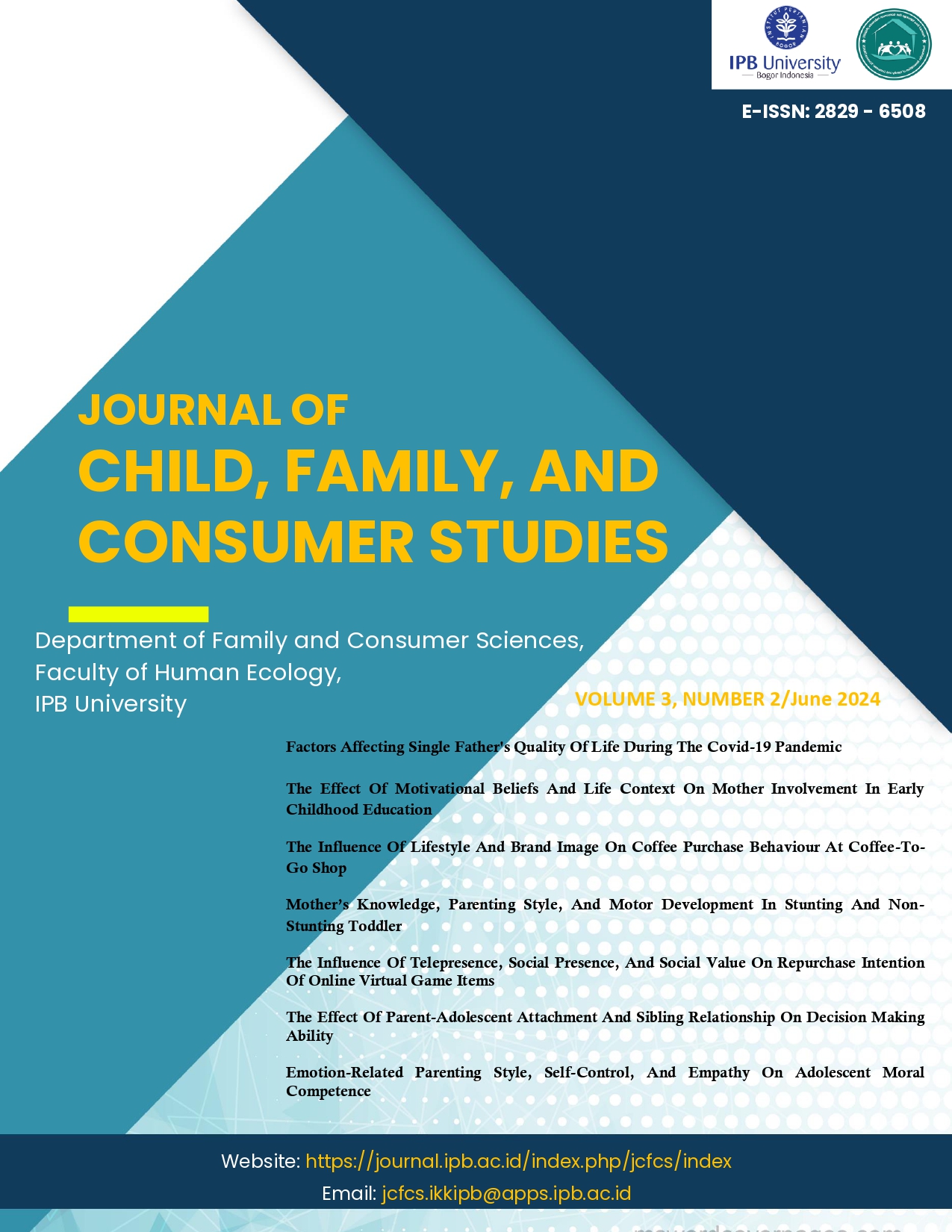THE INFLUENCE OF TELEPRESENCE, SOCIAL PRESENCE, AND SOCIAL VALUE ON REPURCHASE INTENTION OF ONLINE VIRTUAL GAME ITEMS
Abstrak
The emergence of online learning during the COVID-19 pandemic has led to an increase in the use of gadgets by students. The increasingly proficient use of gadgets for teenagers is not only used for learning activities but also for playing online games. This study aims to identify consumer characteristics and influences, telepresence, social presence, social value, and repurchase intention of online game virtual items in adolescents and analyze the relationship between consumer characteristics and repurchase intention of online game virtual items in adolescents. This study involved 239 adolescents who were dominated by males and were in the late adolescent stage with an age range between 19-24 years. The last education of the majority of respondents is high school graduates, and the monthly allowance of most respondents is above Rp1.000.000. Telepresence, social presence, and social value variables are in the medium category, which means they are pretty good. However, the repurchase intention variable is in the low category, meaning the interest in repurchasing online game items is relatively low. Based on the influence test, it can be concluded that telepresence and social value variable has significant effect on repurchase intention.
Referensi
Alfarisi, A. H., Siregar, M. E. S., & Febrilia, I. (2022). Pengaruh nilai-nilai fungsional, sosial, dan emosional terhadap niat beli barang virtual game online. Jurnal Bisnis, Manajemen, Dan Keuangan, 3(1), 297–313. http://pub.unj.ac.id/index.php/jbmk/article/view/656
Animesh, A., Pinsonneault, A., Yang, S. B., & Oh, W. (2011). An odyssey into virtual worlds: exploring the impacts of technological and spatial environments on intention to purchase virtual products. MIS Quarterly, 35(3), 789. https://doi.org/10.2307/23042809
Cairns, P., & Hudson, M. (2014). 6 Measuring Social Presence in Team-Based Digital Games. In Interacting with Presence: HCI and the Sense of Presence in Computer-mediated Environments (pp. 83–101). De Gruyter. https://doi.org/10.2478/9783110409697.6
Cha, J. (2011). Exploring the internet as a unique shopping channel to sell both real and virtual items: a comparison of factors affecting purchase intention and consumer characteristics. Journal of Electronic Commerce Research, 12(2), 115–132. http://www.jecr.org/node/71
Durianto, T. S., & Sugiarto, D. (2004). Strategi Menaklukan Pasar Melalui Riset Ekuitas dan Perilaku Merek. Gramedia Pustaka Utama.
Febrianto, K. W., & Artanti, Y. (2019). Pengaruh nilai konsumsi terhadap niat beli virtual item kustomisasi hero. Jurnal Ilmu Manajemen, 7(2), 471–477. https://ejournal.unesa.ac.id/index.php/jim/article/view/26777
Ha, H., & Lee, J. (2019). The impact of gender on repurchase intention in the virtual game market. Journal of Retailing and Consumer Services, 52, 345–352.
Ho, C.-H., & Wu, T.-Y. (2012). Factors affecting intent to purchase virtual goods in online games. International Journal of Electronic Business Management, 12(3), 204–212. https://www.semanticscholar.org/paper/Factors-Affecting-Intent-to-Purchase-Virtual-Goods-Ho-Wu/53293bb57dd6ce1ae386469912d771e8f902dfba
Hussein, Z., Wahid, N. A., & Saad, N. (2010). Evaluating telepresence experience and game players’ intention to purchase product advertised in advergame. International Journal of Economics and Management Engineering, 4(6), 1365–1370. https://doi.org/10.5281/zenodo.1070131
Leong, P. (2011). Role of social presence and cognitive absorption in online learning environments. Distance Education, 32(1), 5–28. https://doi.org/10.1080/01587919.2011.565495
Liu, X., Lo, V., & Wei, R. (2020). Violent videogames, telepresence, presumed influence, and support for taking restrictive and protective actions. SAGE Open, 10(2), 215824402091952. https://doi.org/10.1177/2158244020919524
Lu, B., Fan, W., & Zhou, M. (2016). Social presence, trust, and social commerce purchase intention: An empirical research. Computers in Human Behavior, 56, 225–237. https://doi.org/10.1016/j.chb.2015.11.057
Maharani, A. S., Fimansyah, W., & Daud, D. (2022). Pengaruh game online terhadap perilaku konsumtif remaja di Desa Tebel Kabupaten Sidoarjo. Buddayah : Jurnal Pendidikan Antropologi, 4(1), 29. https://doi.org/10.24114/bdh.v4i1.35639
Papagiannidis, S., Pantano, E., See-To, E. W. K., & Bourlakis, M. (2013). Modelling the determinants of a simulated experience in a virtual retail store and users’ product purchasing intentions. Journal of Marketing Management, 29(13–14), 1462–1492. https://doi.org/10.1080/0267257X.2013.821150
Patricia, P., & Sahetapy, W. L. (2021). Pengaruh telepresence dan social presence terhadap purchase intention item virtual pada game Battle Royal PUBG. Jurnal AGORA, 9(2), 1–9. https://publication.petra.ac.id/index.php/manajemen-bisnis/article/view/11727
Pelet, J.-É., Ettis, S., & Cowart, K. (2017). Optimal experience of flow enhanced by telepresence: evidence from social media use. Information & Management, 54(1), 115–128. https://doi.org/10.1016/j.im.2016.05.001
Prandini, L. D. Y., & Telagawathi, N. L. W. S. (2021). Faktor-faktor yang menentukan kepuasan pembelian produk virtual dalam online games Mobile Legends. Bisma: Jurnal Manajemen, 7(2), 294. https://doi.org/10.23887/bjm.v7i2.32500
Putra, K., & Atmaja, F. T. (2014). Motif players dalam proses pembelian virtual goods pada permainan game online [Universitas Bengkulu]. https://repository.unib.ac.id/8125/
Qiu, L., & Benbasat, I. (2005). An investigation into the effects of text-to-speech voice and 3D avatars on the perception of presence and flow of live help in electronic commerce. ACM Transactions on Computer-Human Interaction, 12(4), 329–355. https://doi.org/10.1145/1121112.1121113
Saputri, M. E. (2016). Pengaruh perilaku konsumen terhadap pembelian online produk fashion pada Zalora Indonesia. Jurnal Sosioteknologi, 15(2), 291–297. https://doi.org/10.5614/sostek.itbj.2016.15.02.11
Sugiyono. (2019). Metode Penelitian Kuantitatif, Kualitatif & RND. Alfabeta.
Sumarwan, U. (2014). Perilaku Konsumen. Ghalia Indonesia.
Suryanto, R. N., & Kadarisman, Y. (2015). Dampak positif dan negatif permainan game online di kalangan remaja. Jom FISIP, 2(2), 1–15. https://jom.unri.ac.id/index.php/JOMFSIP/article/view/6826
Tu, C.-H., & McIsaac, M. (2002). The relationship of social presence and interaction in online classes. American Journal of Distance Education, 16(3), 131–150. https://doi.org/10.1207/S15389286AJDE1603_2
Turel, O., Serenko, A., & Giles, P. (2011). Integrating technology addiction and use: an empirical investigation of online auction users. MIS Quarterly, 35(4), 1043. https://doi.org/10.2307/41409972
World Health Organization. (2018). Adolescent Health. http://www.who.int/topics/adolescent_health/en/
Yulius, R. (2017). Analisis perilaku pengguna dalam pembelian item virtual pada game online. Journal of Animation & Games Studies, 3(1), 1–14. https://doi.org/10.24821/jags.v3i1.1582
![]() This work is licensed under a Creative Commons Attribution 4.0 International License.
This work is licensed under a Creative Commons Attribution 4.0 International License.













